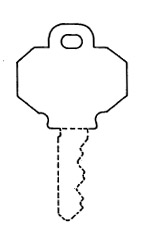Citable No. 55: Baldwin Key Head Shape Has Acquired Distinctiveness, Says TTAB
In its 55th citable decision of 2006, the Board reversed a refusal to register the configuration of a key head (shown below) as a trademark for metal door hardware and key blanks, finding that the mark has acquired distinctiveness. Applicant overcame its lack of "look for" advertising evidence by proving that key head shapes are viewed as trademarks in its field. In re The Black & Decker Corp., 81 USPQ2d 1841 (TTAB 2006).

The sole issue before the Board was whether the configuration has acquired distinctiveness. Applicant, the assignee of Baldwin Hardware, submitted proof that, during the years 2000 to 2004, it spent more that $20 million on advertising and marketing its products, and generated more that $500 million in revenues. Its marketing manager averred that the Baldwin Key Head Design is an arbitrary design, that "it is an industry practice to use different and identifiable key head designs for locksets and keys," that the design has been featured in promotions (including sales person lapel pins), and that since 2001 Baldwin has used an octagonal logo for all its advertising and promotional materials.
In addition, Applicant submitted ten form customer declarations attesting to the distinctiveness of the design, five third-party registrations for marks consisting of other key head designs for door hardware, and photos of ten key heads from other manufacturers of locksets.

The Examining Attorney urged that Applicant's evidence was not enough to open the door to registration, pointing to the lack of "look for" advertising -- i.e., promotion of the design as a trademark. He argued that the sales figures may show the commercial success of the goods, but not that the design is a source indicator. As to the customer declarations, the PTO asserted that eight are from retailers who are biased, leaving a mere two consumer affidavits. The Board noted, however, that the PTO offered no evidence of use of "very similar key head designs by others."

The Board acknowledged that it has, at times, been critical of an applicant's 2(f) claim when "look for" evidence was not provided. Here, however, the Board found the evidence regarding industry practice to be significant.
"the evidence in this case shows that it is common for manufacturers of door hardware to use key head designs as source indicators. This makes it all the more likely that consumers would perceive applicant's applied-for mark as a trademark."
The Board ruled that the absence of "look for" advertising was "not a critical factor in this case." It found the customer declarations to be "clear as to what is understood to represent applicant's applied-for mark," and found no evidence to support the claim of bias.
The Board concluded that Applicant has established a prima facie case of acquired distinctiveness which the PTO had failed to rebut.
TTABlog note: Rarely does an applicant for a product configuration mark clear the distinctiveness hurdle. During the period 2000-2004, only in one of nine such cases did the applicant succeed: In re F. Schumacher & Co., Serial No. 75613624 (April 1, 2004) [not citable] [rounded binding design of wallpaper sample books]. For a discussion of those cases, and of trade dress registration generally, see Welch, "Trade Dress and the TTAB: If Functionality Don't Get You, Nondistinctiveness Will," 18 Allen's Trademark Digest 5 (November 2004).
The Board here noted that "[t]here is no set amount of proof necessary to demonstrate distinctiveness." But it ignored the precedents that hold that, in product configuration cases, the burden of proof is "heavier" because consumers do not associate a product design with a particular producer as readily as they do a trademark or a packaging design. See, e.g., In re Ennco Display Systems, Inc., 56 USPQ2d 1279, 1283 (TTAB 2000).
Text Copyright John L. Welch 2007.

0 Comments:
Post a Comment
<< Home